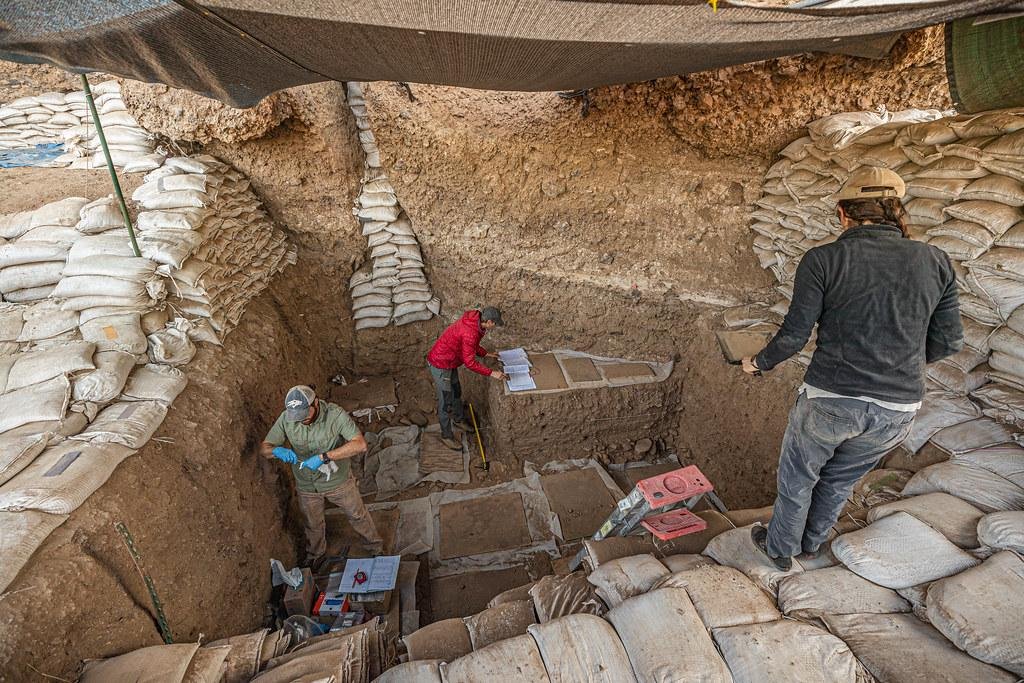Imagine holding a replica of an ancient artifact, feeling every groove and indentation as if it were the millennia-old original. Now, visualize seamlessly reconstructing fragments of long-forgotten civilizations without the fear of further damaging these irreplaceable treasures. Welcome to the transformative world of 3D printing in archaeology. This fascinating intersection of cutting-edge technology and the study of bygone eras isn’t just a glimpse into the past—it’s a leap into the future. In this article, we’ll explore the myriad applications of 3D printing in archaeology, from recreating artifacts and monuments to revolutionizing research and education. We’ll also peer into the crystal ball to see what the future holds for this dynamic synergy of past and present. Grab your explorer’s hat and your digital toolkit as we dive into the innovative frontier of archaeology enhanced by 3D printing.
Unveiling the Past: How 3D Printing is Revolutionizing Archaeological Discoveries
The realm of archaeology has never been more vibrant, thanks to the invaluable integration of **3D printing technology**. This revolutionary tool breathes life into ancient artifacts, allowing researchers and enthusiasts alike to explore history in unprecedented ways. When a fragile fossil or artifact is discovered, it often needs intricate conservation efforts. With 3D printing, these delicate finds can be swiftly scanned and rendered into accurate replicas, preserving the original while allowing for detailed analysis. This approach not only provides a **non-invasive method** of study but also opens doors for public exhibitions, where exact replicas replace original artifacts, thus protecting them from potential damage.
Furthermore, **digital reconstruction** has taken a monumental leap forward. Sites that have been eroded by time or human activity can be digitally recreated using fragmentary evidence, with 3D printing playing a significant role. Archaeologists can now extract more contextual information from fragments and produce complete models. Imagine holding a meticulously reconstructed vase from ancient Greece or a perfectly replicated dinosaur bone—tools that were once parts of a distant past can now be grasped and examined. The impact is profound within educational settings, as students can interact with history tangibly. Common applications include:
- Replicating Artifacts: Enables detailed study while preserving originals
- Restoration Projects: Creates missing parts of artifacts
- Educational Models: Facilitates hands-on learning
- Public Exhibitions: Stabilizes preservation efforts
| Application | Benefit |
|---|---|
| Digital Reconstruction | Revives lost historical contexts |
| Artifact Replication | Protects original pieces |
| Educational Use | Enhances learning experiences |
| Exhibition Models | Safeguards artifacts during display |
Bridging Time Gaps: Replicating Artifacts with Unprecedented Accuracy
In the quest to understand our history and preserve cultural heritage, 3D printing technology has become a revolutionary tool for archaeologists. With **unparalleled precision**, researchers can create accurate replicas of ancient artifacts, allowing for detailed study without risking damage to the original pieces. The ability to reproduce artifacts with such fidelity brings a new dimension to archaeological research, enabling hands-on exploration by both scholars and the general public. These replicas can serve as educational tools in museums, providing tangible connections to our past, and ensuring that the fragile originals are safeguarded. This bridging of time gaps not only enriches our understanding but also democratizes access to history, making it more inclusive and interactive.
Moreover, the applications extend beyond mere replication. **3D printed artifacts** can be used in fieldwork to test ancient technologies and construction techniques. For instance, creating models of tools or architectural elements can help hypothesize their original uses or methods of assembly. It also enables collaborative work across the globe, with digital files easily shared and printed in various locations. This global connectivity fosters a more integrated approach to archaeological studies. Additionally, researchers can use 3D models to analyze wear patterns, simulate aging, and even reconstruct missing parts, providing new insights that were previously unattainable. Here is a brief comparison of traditional methods versus 3D printing in archaeology:
| Aspect | Traditional Methods | 3D Printing |
|---|---|---|
| Accuracy | Moderate | High |
| Replication Time | Weeks/Months | Hours/Days |
| Cost | Expensive | Cost-effective |
| Accessibility | Limited | Wide |
Hands-On History: Educational Benefits of 3D Printing in Archaeology
Engaging students in archaeology has always been a challenge, but **3D printing** is revolutionizing how we connect with ancient cultures. By bringing physical reconstructions of artifacts into the classroom, learners can experience a tangible connection to history like never before. Imagine holding a perfectly replicated **Roman coin** or examining a **fragment of a pottery vessel** from ancient Greece. These tactile experiences not only foster a deeper understanding of historical contexts but also **enhance cognitive learning** by integrating visual and kinesthetic elements. Moreover, students develop **problem-solving skills** as they grapple with the process and practicality of creating accurate prints from digital models.
The crossover between technology and archaeology offers several educational benefits that extend beyond simple artifact replication. Using 3D printing, educators can create **interactive models** of historical sites, enabling students to explore environments that are otherwise inaccessible. For instance, creating a miniaturized model of the **Great Wall of China** or an **Egyptian pyramid** provides a multilayered educational experience. The technology also allows for customization to focus on specific features, like **architectural designs** or **construction techniques**. Here’s a quick comparison of traditional vs. 3D printed models in education:
| Aspect | Traditional Models | 3D Printed Models |
|---|---|---|
| Detail Accuracy | Moderate | High |
| Customization Options | Limited | Extensive |
| Student Engagement | Varies | Enhanced |
Beyond the Excavation: Future Trends and Best Practices for 3D Printing in Archaeological Research
As we look beyond the sheer act of excavation and into the future trends, **3D printing** will continue to revolutionize how we **preserve**, **study**, and **share** archaeological finds. Cutting-edge techniques such as bio-printing and multi-material printing are appearing on the horizon, offering potential to replicate not just the shape but also the texture and composition of ancient artifacts. This is particularly exciting for fragile or degraded specimens, allowing scholars to handle and study accurate replicas without risking damage to the original items.
**Best practices** are emerging around the ethical and sustainable use of 3D printing in archaeological research. This includes:
- Ensuring digital records and printed models are accurately documented and indexed for future reference.
- Incorporating **community involvement** to make archaeological findings accessible to non-experts.
- Promoting **open-source sharing** of 3D models to enhance global collaborative efforts.
Furthermore, data from 3D scans can be stored in widely accessible formats. Let’s take a look at the benefits:
| Benefit | Explanation |
|---|---|
| Global Access | 3D models can be shared online, allowing researchers worldwide to access the data. |
| Enhanced Analysis | Detailed replicas enable advanced techniques like virtual dissection and comparative studies. |
Q&A
Q&A: Unfolding the Mysteries of the Past with 3D Printing in Archaeology
Welcome, curious minds! Today, we’re diving into the fascinating world where cutting-edge technology and ancient history collide. Yes, we’re talking about the groundbreaking use of 3D printing in archaeology. Let’s explore this captivating topic together with some friendly Q&A!
Q1: What exactly is 3D printing, and how does it relate to archaeology?
A1: Great question! Think of 3D printing like a magical sculpting tool. It uses digital designs to create physical objects layer by layer, transforming imaginative concepts into tangible items. In archaeology, 3D printing isn’t just a techie gimmick; it’s a powerful tool that brings ancient artifacts back to life. Imagine holding a perfectly recreated replica of a centuries-old relic—3D printing makes that possible, enabling archaeologists to study and share heritage in more interactive ways.
Q2: How can 3D printing help in the study and preservation of historical artifacts?
A2: Excellent point! 3D printing offers a transformative approach to preservation and study. By creating accurate replicas of fragile artifacts, researchers can analyze them without risking damage to the originals. These replicas can be shared with museums, educational institutions, and even used for public displays, making history more accessible. Moreover, the digital models used in 3D printing can be stored indefinitely, ensuring that data about these precious objects is preserved even if the original material degrades over time.
Q3: Are there any specific examples where 3D printing has made a significant impact in archaeology?
A3: Absolutely! One notable example is the recreation of King Tutankhamun’s tomb. Using detailed scans and 3D printing technology, researchers recreated an exact replica of the tomb, which allows visitors to experience this ancient marvel without the wear and tear on the original site. Another inspiring instance is the reconstruction of damaged artifacts from conflict zones. Through 3D printing, lost or destroyed pieces of our shared cultural heritage can be reconstructed, offering hope and continuity in the face of destruction.
Q4: What does the future hold for 3D printing in the field of archaeology?
A4: The future looks incredibly promising! As 3D printing technology continues to evolve, its applications in archaeology will only expand. We can anticipate more precise and even larger-scale reproductions of ancient sites, allowing for virtual tours and immersive educational experiences. Additionally, advancements in materials could lead to more accurate and durable replicas, enhancing both study and display. Plus, with collaborative projects across the globe, 3D printing can bridge gaps between researchers and enthusiasts, fostering a global community devoted to preserving the past.
Q5: How can the general public get involved or benefit from 3D printing in archaeology?
A5: Now that’s the spirit of curiosity! Thanks to 3D printing, archaeology is becoming more inclusive and engaging than ever. Museum visitors can interact with 3D printed replicas, gaining a tactile understanding of history. Enthusiasts can even access digital models to print their own replicas at home, sparking a personal connection to ancient cultures. Educational programs incorporating 3D models offer students a dynamic way to learn about history, igniting a passion for exploration and discovery. So, whether through visiting exhibitions, participating in workshops, or printing your own historic artifacts, there are myriad ways to dive into the world of 3D printing in archaeology.
And there you have it, fellow adventurers! The blend of 3D printing and archaeology is not just about preserving the past; it’s about bringing it forward to enrich our present and inspire our future. Who knew technology could make history this exciting? Until our next historical detour, keep exploring and stay curious!
In Retrospect
As our journey through the multifaceted world of 3D printing in archaeology draws to a close, it’s clear that we are on the brink of a thrilling renaissance. These innovative technologies are not just reshaping artifacts but are also reconstructing our understanding of the past, layer by meticulous layer. By bridging the gaps between ancient civilizations and the present day, 3D printing is providing both scholars and enthusiasts with the tools to unlock the mysteries of history in ways previously deemed unimaginable.
From virtual reconstructions of ancient relics to the vibrant replication of historic artifacts, the applications are as infinite as the riddles waiting to be unraveled. Imagine walking through a museum where you can touch the intricate carvings of a long-lost temple, or students in a classroom holding accurate replicas of ancient pottery. This isn’t the domain of fantasy anymore, but our tangible reality.
As we veer into the future, the prospects of 3D printing beckon us to embrace a more immersive and comprehensive understanding of our heritage. Who knows what archaeological wonders await, merely a print away? So, let’s keep our curiosity alight, and our imaginations unshackled. The odyssey into our shared past, enriched with the marvels of 3D technology, has only just begun. Get ready to rediscover history, one layer at a time.

